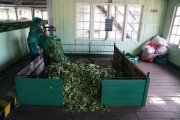Energy
The world is warming up. Almost all of this is the result of human activities - mainly industry - from emissions of greenhouse gases. The main greenhouse gas is carbon dioxide - some 80% of emissions in industrialized nations. Carbon dioxide, or CO2, mainly comes from burning fossil fuels like coal, petrol, oil and natural gas. By sector, some 33% comes from electricity generation and 42% from heating buildings.
Steenbergs' Targets
| Target (2016 - 2025) | Target | Actual 2019 |
| Reduction in energy consumption (kWh) by 2025 | -30% | -16% |
| Contribution by own generated solar energy by 2025 | 33% | 29% |
| Energy mix from renewable and nuclear sources by 2025 | 100% | 52% |
How's Steenbergs doing this?
Power
We have been getting our power through a mix of solar panels on the roof of 6 Hallikeld Close that generate a decent amount of electricity, some from Scottish Power (now switched to Octopus Energy) and the rest from British Gas at 11 Hallikeld Close.
For comparison, British Gas is 65% sourced from nuclear and renewables, and Scottish Power is 31% from nuclear and renewables. As these contracts come up for renewal, we will move to more environmentally sustainable fuel mixes.
In June 2020, we switched from Scottish Power to Octopus Energy (100% renewable energy), so we will be close to our energy mix targets by end 2020, taking into account solar energy (see below).
The installation of solar photovoltaic cells on the roof of 11 Hallikeld Close was completed in March 2020, which will help our solar and renewables targets. This solar PV on 11 Hallikeld provides a theoretical 11.8kW per annum, which we reckon will deliver c. 10kW a year.
Therefore, between 6 and 11 Hallikeld Close, self-generated power via solar panels gives Steenbergs c. 40% of its power needs. So, by end 2020, we will have hit our 2025 generation target and exceed it from 2021. Then, by end 2020, c. 98% of our power will come from renewables, so the 100% by 2025 renewables target looks achievable.
Steenbergs does not have any other energy sources, so no gas or petroleum is used directly by our commercial activities.
Lighting
The need for lighting is reduced through using clear panels (wherever practical) in the roof of our buildings and the ceilings of the office and production areas - the warehouses include some clear roof tiles, but we have had to forego some of these for solar panels. Electrical lighting is used to supplement natural light wherever possible, rather than for the sake of it.
Sunpipes have been installed in the changing area to minimize the requirement for electrical lighting and we have installed Ecoplus windows. Ecoplus windows use Forestry Stewardship Council certified wood, which has been boron treated for an environmentally friendly wood treatment, and Iplus ultra-efficient glazing and are painted with natural plant-based paints that contain no biocides.
Lamps used are low energy options. During 2019, all lighting was converted from incandescent bulbs and fluorescent tubes to LED panels. Also, in 2019, additional motion sensors were installed to reduce the possibility of lights being left on where there is no activity.
Heating & Insulation
Heating is all provided from electricity and we do not use gas, oil or other products. In general, we have a relatively low requirement for heating as we do not use heat in our manufacturing processes.
At Steenbergs, we have also invested in double glazing and insulation for our offices and insulation for our production areas to minimise heat loss, while our warehouses are unheated.
The office, kitchen, labeling and changing areas in the main warehouse are insulated using Warmcell 100 and Homatherm Flexcel 040 for the roof areas and the walls respectively. Warmcell is used in the roof areas and is made from 100% recycled newsprint, while Homatherm is used for wall areas and is made from recycled newsprint and recycled jute sacking.
The main warehouse is lined with food grade paneling from Stancold, which has a mineral fibre insulation incorporated into the panels. Its Rockwool core is water repellent, free of (H)CFCs and fully recyclable.
Steenbergs' office and dispatch building has traditional mineral fibre insulation throughout.
Other
Finally, we use thrifty good housekeeping techniques, including the Carbon Trust's handy stickers and posters.
Staff have been trained in the basic task of "Switching Off When Not Needed" coupled with signs to remind everyone to minimize wastage. Nevertheless, Axel and Sophie Steenberg spend their lives going around switching off lights and radios that have been left on!
In 2019, all our computers and telephones were upgraded to newer models, which are more energy efficient, while the server is shut down at weekends when no-one is working.

 Print this page
Print this page Bookmark this page
Bookmark this page